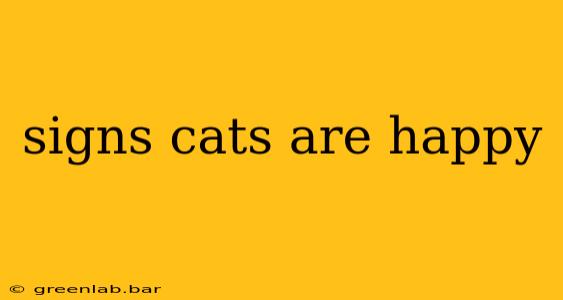Cats, those enigmatic creatures, often communicate their happiness in subtle ways. Understanding their body language is key to recognizing when your feline friend is truly content. While a purr might be the first thing that comes to mind, there's a whole spectrum of behaviors that indicate a happy kitty. This guide will decode those signals, helping you deepen your bond and better understand your furry companion.
The Purrfect Indicators: Body Language Speaks Volumes
Forget the myth that purring only signifies contentment; while it often does, it can also be a sign of pain or stress in some situations. However, when combined with other positive body language cues, purring is a strong indicator of happiness. Let's explore some key signs:
1. The Slow Blink: A Cat's "I Love You"
The slow blink is perhaps the most significant indicator of feline affection. When your cat slowly closes and opens its eyes, it's a sign of trust and comfort, akin to a human smile. Try it back – slowly blink at your cat; if they reciprocate, it's a clear sign of a happy, secure bond.
2. Happy Purrs: More Than Just a Sound
As mentioned earlier, a purr alongside other positive signs is a reliable indicator of contentment. Listen to the tone of the purr – a low, rumbling purr is generally associated with relaxation and happiness.
3. Tail Talk: The Language of the Tail
A happy cat usually has a tail that's upright and slightly curved at the tip, like a question mark. A relaxed, gently swaying tail also suggests contentment. Avoid confusing this with a stiff, puffed-up tail, which often indicates fear or aggression.
4. Kneading: A Comforting Ritual
Kneading, often referred to as "making biscuits," is a behavior that originates from kittenhood. Cats knead to release endorphins and feel secure, often associated with happy memories of nursing. If your cat kneads on you, consider it a sign of deep affection and trust.
5. Vocalizations: Beyond the Meow
While meows are common, happy cats might also exhibit other vocalizations, such as chirps, trills, or soft meows. These often accompany playful interactions or greetings.
Beyond the Basics: Other Signs of Feline Felicity
The signs listed above are prominent, but several other subtle cues can reveal your cat's happiness:
6. Playful Behavior: A Happy Cat at Play
A cat that engages in playful behavior, such as chasing toys, batting at string, or pouncing on objects, is undoubtedly happy and energized. Observe their enthusiasm – a genuinely happy cat will be fully engaged and energized during playtime.
7. Relaxed Posture: A Comfortable Cat
A relaxed cat will often have a loose, supple body posture. Their ears will be pointed forward, and their whiskers will be relaxed, not pulled back.
8. Rubbing Against You: Marking Their Territory (with Love)
Cats rub against people and objects to leave their scent, claiming them as part of their territory. When they rub against you, it's a significant sign of affection and comfort.
9. Sleeping Soundly: A Sign of Security
A cat that sleeps soundly and peacefully is a happy cat. A comfortable sleeping position, often curled up in a safe spot, demonstrates a sense of security and contentment.
10. Healthy Appetite: A Happy Tummy
A healthy appetite is a good indicator of overall well-being. If your cat is eating regularly and with gusto, it suggests they are happy and healthy.
11. Grooming Habits: A Sign of Self-Care
A well-groomed cat is often a happy cat. Regular grooming is a sign of self-care and contentment.
12. Exploration and Curiosity: A Sign of Confidence
A curious cat that explores its environment confidently and without fear is generally a happy cat.
13. Interaction with Other Pets: A Social Butterfly
If your cat interacts positively with other pets in your household, it shows a happy social life. Observe how they play and interact to gauge their comfort level.
14. A Shiny Coat: A Healthy and Happy Cat
A shiny, healthy coat is a visual sign of your cat's overall well-being and contentment.
15. Responsiveness to Your Attention: A Bond of Trust
A cat that readily responds to your attention, whether it's through petting, talking, or playing, is a happy cat that feels safe and loved.
Understanding Your Cat: A Journey of Love and Observation
Learning to read your cat's body language takes time and patience. Pay close attention to their subtle cues, and you'll gain valuable insights into their emotional state. By understanding their happiness, you can build a stronger bond and create a more enriching environment for your beloved feline companion. Remember, each cat is an individual, so what might be a clear sign of happiness in one cat might be different in another. Trust your instincts and enjoy the journey of getting to know your unique furry friend.

